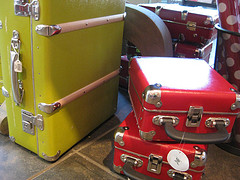Packing Smart: Best Tips from Travel Experts
29 June 2012
As airlines increase fees for every checked bag and the TSA makes liquids difficult to pack, travelers have been doing some careful soul-searching about how and what they pack when they travel.
Once the norm, over-packed bags now slow down security lines and cause distress for travelers when opened.
Packing smart really comes down to packing light and taking along only what you absolutely need for your trip. It also means grouping items into smaller bags that can speed the security process.
We’ve culled through the tips delivered by travel experts to find the latest and most useful packing strategies.
1. Plan ahead
Plan ahead by knowing what type of weather you can expect on your trip and the activities you’ll participate in. Don’t pack new clothing items because you’ll want to be confident in how it fits and feels. You can expect to wear each clothing item more than once, so choose versatile pieces that can be mixed and matched into multiple combinations and layered when necessary. Two pairs of shoes – one dressy, one casual – are all you need in addition to the ones you wear en route.
2. Pick the right suitcase
Structured suitcases with wheels afford a traveler a great deal of mobility and speed, which can be important in today’s busy airports. Still, you’ll need to be able to carry it up and down stairs and over rough terrain on some trips. Bags without wheels or structure, however, are generally easier to cram into spaces like the overhead bin or the trunk of a car. Still, it needs to be light enough that you can carry it comfortably over a distance.
Also, if you plan to carry your suitcase on board the plan and avoid baggage fees, make sure your bag will fit the airline’s carry-on requirements. Each airline has their own, but standard dimensions are 22″ x 9″ x 14″.
3. Pay attention to the packing process
The process of packing is just as important as what you pack. Fill all empty spaces, like shoes, with other smaller items. Pack smaller, like items together in compression sacks or packing cubes (see Magellan’s or packing folders and cubes for some excellent packing aids).
When it comes to clothing, many people fold their clothes the way they see at retail stores, but that’s not the most efficient use of space. Rolling t-shirts lets a traveler pack them into empty spaces and they can be wrapped around items that could use a little padding, like sunglasses. The remaining clothes can be layered flat across the width of the suitcase.
4. Pack a lock
Today’s airport security rules dictate that luggage must be unlocked or locked with a TSA-approved lock, but even if you don’t lock your suitcase in transit, the ability to lock your luggage when you arrive can be handy. These days, you can buy cable locks that can be used to lock your bag from being opened but also secure it to an immovable object (like the drain pipe in the bathroom of your hotel room).
5. Be prepared
Packing light doesn’t mean leaving behind bright accessories or other special touches that can make your trip safer and more comfortable. Earplugs, eye masks, and a flashlight are all useful for getting sleep or finding your way around an unfamiliar room in a blackout. They also don’t take up much space.
Light accessories like a silk scarf or a pretty clutch can dress up a woman’s outfit if you find yourself invited to a dressy affair and, again, it doesn’t take up much space. Do not pack expensive jewelry as that’s more likely to make you a target for mugging or theft. Plus, those items won’t be covered by the airline or your travel insurance baggage protection if they’re stolen from your bag.
6. Put these in your carry-on
One final note. Whether you check a bag or not, these items always go in your carry-on:
- Eyewear
- Cash and credit cards
- Passport
- Medications
- Electronics
- Camera
- Copy of your travel insurance and itinerary
- Photos of your traveling companions
- Water bottle
There are several reasons these items should be in your carry-on.
- If your bag is delayed or stolen outright, these are the items you’ll need to get your trip back on track.
- If your trip is delayed, these are the items you’ll most likely need along the way.
- Many of these items are not covered by your travel insurance baggage protection; or they’re covered only up to a plan limit.
Making room for souvenirs
If you find you’ve purchased a fair share of souvenirs on your trip and you’re wondering how to get them home, consider a few options:
- Visit a local pack-and-ship facility and send them to your home address
- Ship your dirty laundry instead and pack the souvenirs in your bag for the return trip
See also
Damian Tysdal is the founder of CoverTrip, and is a licensed agent for travel insurance (MA 1883287). He believes travel insurance should be easier to understand, and started the first travel insurance blog in 2006.

